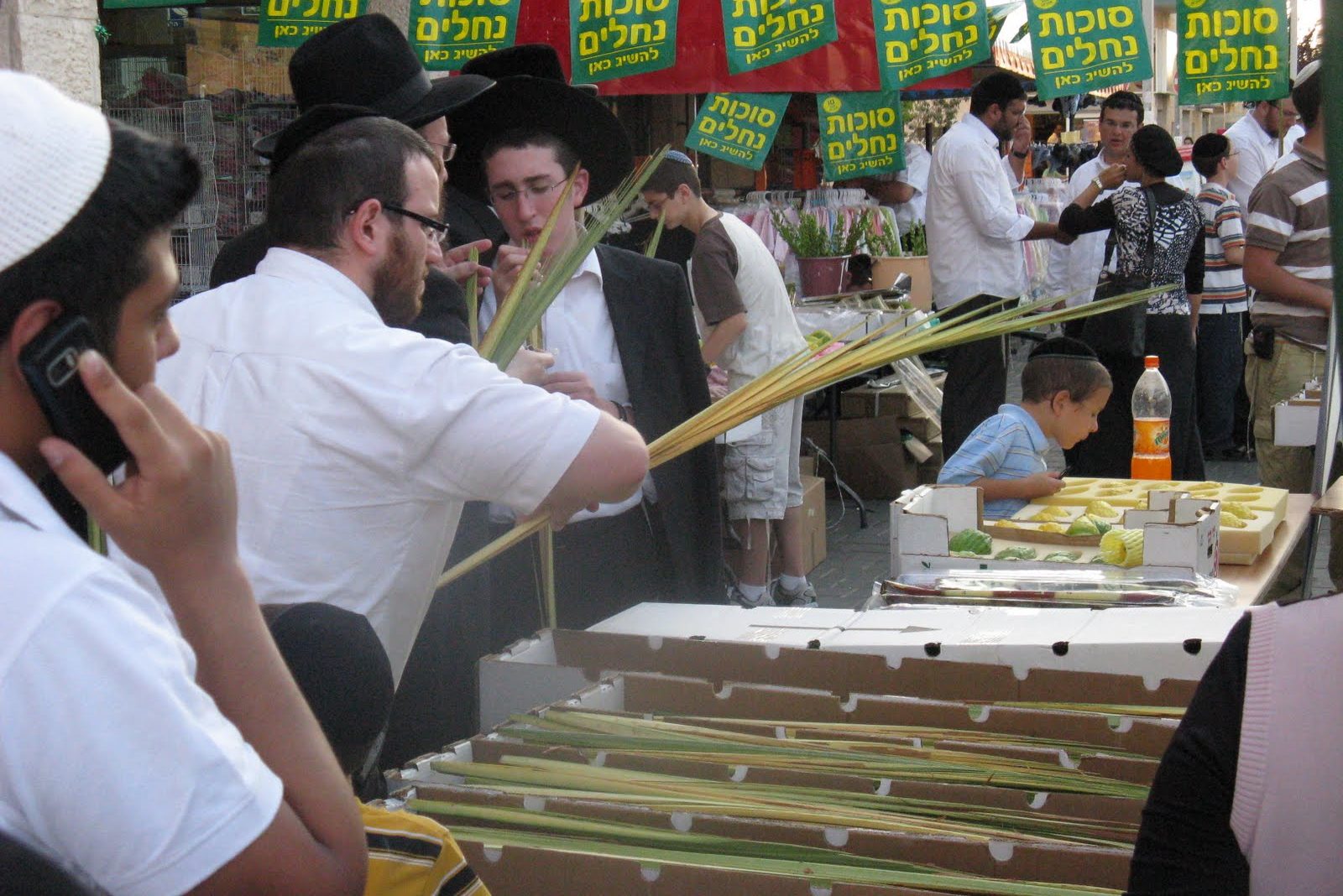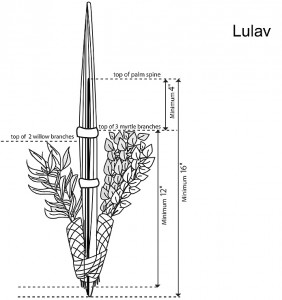Lulav: If First Day of Sukkot Is Shabbat
You do not need to buy a fancy or expensive lulav and etrog if the first day of Sukkot is Shabbat, since the Torah requirement for the Etrog to be beautiful is only on the first day of Sukkot.
Palm Branch Sizes
Minimum length for lulav (palm branch): Spine must be at least 16″ long, not including the length of the leaves. At least 4″ of the spine of the lulav must be above the tops of the willows and myrtles.
Myrtle and Willow Branch Sizes
Each of the myrtle and willow branches must be at least 12 inches long.
Lulav: Choosing: Condition
A lulav, willow branches, or myrtle branches are only disqualified/pasul if the leaves are so dry that they will crack if you bend them. Being moldy does not disqualify them.
To Set Up a Lulav
To set up a lulav: hold with spine facing you, with three myrtle branches (hadassim) on the right and two willow branches (aravot) on the left. It is customary to put the myrtle and willow branches into a holder made of palm leaves.
Lulav: When You May Borrow
You may borrow a lulav on all days of Sukkot except the first day (or first two days outside of Eretz Yisrael). On the first (two) day(s), you may acquire a lulav and etrog by having a friend “give” them to you as a gift, even if you will later “give” them back to your friend, also as a gift.
Note: If you intended to use someone else’s lulav on the first day of Sukkot, it is considered as if the lulav is yours, even without doing the normal acquisition.
Lulav: Husband and Wife
A man’s wife does not own the lulav with him (and a wife’s husband does not own her lulav), but it is assumed that each gives their lulav to the other (on the first and second day of Sukkot) as a gift with a condition that the recipient will give the lulav back to the other spouse as a gift once finished.
Lulav: Who Should Bless: Women
Women and girls do not need to bless over or wave the lulav; but if they do, it is a mitzva.
Lulav: Where To Bless: Sukka or Synagogue
Say blessings on the lulav and etrog in the sukka or in synagogue.
Lulav: When To Bless: Daytime
Only say the blessing on the lulav during the day.
Lulav: Shabbat
Don’t pick up the lulav or say the blessing on Shabbat.
Lulav: Hold, Bless, Shake
To fulfill the commandment of lulav and etrog, you must hold them together the way they grow: stems down. But since you fulfill the commandment as soon as you hold the Four Species together this way, you must first pick up the etrog inverted (stem up) and then say the blessing, as follows:
- Hold the lulav with the spine facing you and the myrtle on the right, willows on the left, and the etrog with the pitom (opposite the stem) down;
- Say the blessings for the lulav;
- Turn the etrog right side up (stem-side down) and hold the lulav and etrog together; and
- Shake the Four Species together.
Note: Waving (or shaking) the lulav is a universally accepted custom with the force of halacha. We show that God is present in all directions by waving the lulav in the four compass directions, plus up and down. There are various customs of the sequence in which to wave the lulav. One common sequence is east; south; west; north; up; down. Wave the Four Species three times in each direction.
Note: Although the lulav’s spine should face you as you hold it, you have still fulfilled the requirement of lulav if the spine was facing away or if the willows and myrtles are on the incorrect sides of the lulav.
Lulav: Hallel at Home or in Synagogue
Ideally, take your lulav and etrog to synagogue and say hallel with the minyan. B’di’avad, it is OK to say hallel and the blessings and wave the lulav at home.
Lulav: How to Wave During Hallel
Wave the lulav in all six directions each time when saying Hodu l’Adonai… and, later, Ana Adonai… and again in the final Hodu in Hallel:
- Hold together the lulav and etrog during the entire procedure, pitom up, etrog in left hand.
- At each word in Hodu l’Adonai… and at each syllable in Ana Adonai, shake the lulav/etrog together three times, advancing through the sequence of east, south, west, north, up, down.
For Hodu l’Adonai:
- At Hodu, shake three times to the east;
- At l’Adonai, don’t shake but hold the lulav and etrog up while standing straight;
- At ki, shake three times to the south, etc..
For Ana Adonai:
- At “A,” shake three times to the east;
- At “na, shake three times to the south;
- At Adonai, stand straight and hold the lulav and etrog up;
- At “ho,” shake three times to the west;
- At “shi,” shake three times to the north, etc.
Lulav: Storing: Replacing into Water
You may put the myrtle and willow branches into water after using them only if they were in water before the Sukkot holiday began. You may not add water on Shabbat, but you may on the other Jewish festival days. You may change the water only on chol ha’moed.
Lulav: Disposing
You may dispose of a lulav in any way that is not degrading. So, you may drop it into a field or put it on a lawn–unless animals might eat it or step on it or if it will be subject to poor treatment before it decays. Don’t dispose of a lulav or etrog directly into the garbage. Burn, bury, or wrap them in a bag or one layer of plastic and you may throw it into normal garbage.
Hoshanot: Joining
Hoshanot were done in the Temple in Jerusalem and the community is required to do hoshanot. Individuals are not required to join, but it is the proper practice to join if holding a lulav and etrog.
Copyright 2015 Richard B. Aiken. Halacha L’Maaseh appears courtesy of www.practicalhalacha.com Visit their web site for more information.
This material is provided for informational purposes only – and is not a substitute for the consultation of a competent rabbi.


